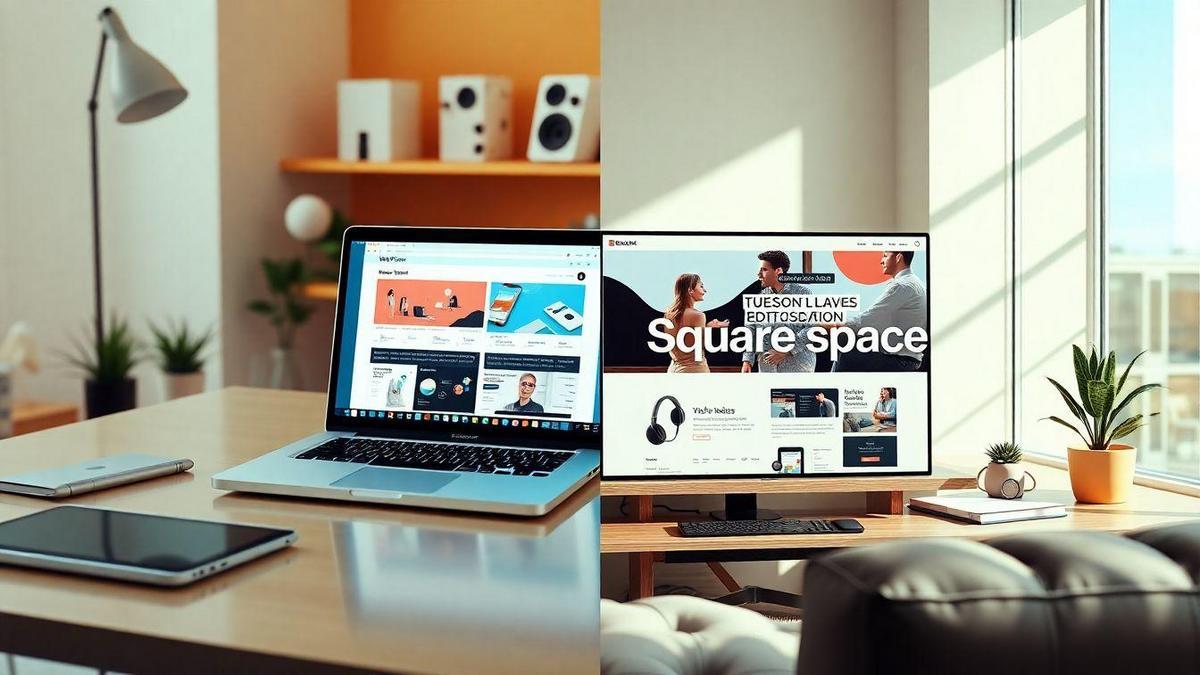In this Webflow vs. Squarespace Comparison: Is It Worth Migrating?, you’ll dive into the unique features of both platforms. You’ll discover how Webflow’s customization shines alongside Squarespace’s easy-to-use templates. We’ll break down costs, usability, and even the best choice for beginners. Plus, you’ll find out which platform can give your site the speed, SEO, and support it needs. Let’s get started!

Key Features of Webflow vs Squarespace
Understanding Webflow Characteristics
Webflow is all about flexibility and design control. If you love to tinker with your website’s look and feel, Webflow gives you that freedom. You can create custom layouts without needing to know how to code. Imagine having a blank canvas where you can drag and drop elements, adjust styles, and see changes in real-time.
Here are some standout features of Webflow:
- Visual Editor: Design your site while seeing exactly how it will look.
- CMS Functionality: Perfect for blogs or portfolios, you can manage content easily.
- Responsive Design: Your site will look good on any device, from phones to desktops.
- Custom Interactions: Add animations and transitions to make your site pop.
Exploring Squarespace Functionalities
On the flip side, Squarespace is known for its all-in-one approach. It’s a great option if you want everything set up quickly. You can choose from beautiful templates, and they handle the technical stuff for you.
Here are some key features of Squarespace:
- Template Variety: Tons of stylish templates to choose from.
- E-commerce Tools: Great for selling products online.
- Built-in SEO: Helps your site rank better in search engines.
- 24/7 Support: Always someone to help if you run into problems.
How These Features Impact Your Choice
When deciding between Webflow and Squarespace, think about what you need. If you want to dive deep into design and customization, Webflow might be your best bet. But if you prefer a more straightforward, ready-to-go approach, Squarespace could be the way to go.
Here’s a quick comparison table to help you see the differences:
| Feature | Webflow | Squarespace |
|---|---|---|
| Design Flexibility | High | Moderate |
| Template Options | Limited | Extensive |
| E-commerce Capabilities | Advanced | User-friendly |
| Customer Support | Community-based | 24/7 Support |
In the end, your choice boils down to what fits your needs best. Are you looking for creative freedom or an easy setup?
Cost Comparison: Webflow vs Squarespace
Analyzing Webflow Pricing
When you’re looking at Webflow, you’ll find a range of pricing plans that might catch your eye. They offer different tiers depending on what you need. Here’s a quick breakdown:
| Plan Type | Monthly Cost (billed annually) | Features Included |
|---|---|---|
| Basic | $15 | Good for simple sites, includes hosting. |
| CMS | $20 | Ideal for blogs, includes content management. |
| Business | $45 | Great for larger sites, includes additional features. |
| Enterprise | Custom Pricing | Tailored solutions for big businesses. |
So, if you’re building a simple site, the Basic plan is a good start. But if you have a blog or need more features, consider stepping up to the CMS plan.
Evaluating Squarespace Costs
Now, let’s take a look at Squarespace. Their pricing is also straightforward but a bit different. Here’s how it stacks up:
| Plan Type | Monthly Cost (billed annually) | Features Included |
|---|---|---|
| Personal | $16 | Great for personal sites, includes basic features. |
| Business | $26 | Perfect for small businesses, includes e-commerce. |
| Basic Commerce | $30 | Good for online stores, includes more selling tools. |
| Advanced Commerce | $46 | Best for serious e-commerce, includes advanced features. |
If you’re just starting, the Personal plan might fit the bill. But if you want to sell online, you might want to look at the Business plan.
Which One Fits Your Budget Best?
Now, let’s get to the heart of the matter: Which one fits your budget best?
- If you’re on a tight budget and need something simple, Webflow’s Basic plan is slightly cheaper than Squarespace’s Personal plan.
- However, if you’re looking to build a blog or an online store, both platforms offer plans that can fit, but Squarespace might provide more features for e-commerce at a slightly higher cost.
In the end, it’s all about what you need. If you want more design freedom, Webflow is your go-to. But if you prefer an easier setup, Squarespace could be your best friend.

Usability: Which Platform is Easier?
Navigating Webflow’s Interface
When you dive into Webflow, you might feel like you’re stepping into a designer’s playground. The interface is clean and modern, making it easy to find what you need. You can drag and drop elements, which feels pretty intuitive. However, it does have a bit of a learning curve. If you’re someone who enjoys tinkering and customizing, you might love it. But if you prefer a straightforward approach, you may find yourself scratching your head a bit.
User Experience with Squarespace
Now, let’s chat about Squarespace. If you want a platform that feels like a cozy home, Squarespace might be the right choice. The interface is user-friendly. You can easily add text, images, and videos without breaking a sweat. Plus, the templates are stunning right out of the box! It’s designed for those who want to get a beautiful site up and running quickly. You won’t need a degree in web design to make it work.
Finding the Right Fit for You
So, how do you decide between Webflow and Squarespace? Here’s a quick table to help you weigh your options:
| Feature | Webflow | Squarespace |
|---|---|---|
| Ease of Use | Moderate Learning Curve | Very User-Friendly |
| Customization Options | Highly Customizable | Limited Customization |
| Templates | Minimal but Flexible | Beautiful Pre-Designed |
| Ideal For | Designers & Tinkerers | Small Business Owners |
In the end, it really depends on what you’re looking for. If you want flexibility and don’t mind spending some time learning, Webflow might be your jam. But if you want to get things done quickly with a beautiful design, Squarespace could be your best bet.
Design Customization Options
Custom Designs with Webflow
When you think about creating a website, Webflow offers a fantastic way to make it your own. With its custom design tools, you can build a site that truly reflects your style. You can play around with colors, fonts, and layouts. It’s like having a blank canvas where you can splash your creativity.
One of the best parts? You don’t need to know how to code! Webflow lets you drag and drop elements, making it super easy to create stunning designs. Plus, if you ever feel stuck, their helpful tutorials can guide you through the process.
Squarespace’s Design Templates
On the flip side, Squarespace gives you a selection of beautiful templates to choose from. These templates are professionally crafted and can save you a lot of time. Imagine picking a template that already looks great and just filling in your content. It’s like having a pre-made cake where you just add your favorite frosting!
Here’s a quick comparison of both options:
| Feature | Webflow | Squarespace |
|---|---|---|
| Customization Level | High | Moderate |
| Ease of Use | Moderate | High |
| Template Variety | Limited | Extensive |
| Learning Curve | Steeper | Gentle |
How Design Affects Your Brand Image
Your website design plays a key role in how people see your brand. A well-designed site can make you look professional and trustworthy. Think about it: when you visit a website that looks outdated or messy, do you feel confident buying from them? Probably not!
A good design can create a lasting impression. It can connect with your audience and make them feel at home. So, whether you choose Webflow or Squarespace, remember that the design you pick can shape how people view your brand.

Pros and Cons of Migrating to Webflow
Advantages of Migrating to Webflow
When you think about moving to Webflow, there are some fantastic benefits that might catch your eye. Here’s a quick rundown of what makes Webflow shine:
- Visual Design Flexibility: Webflow lets you create stunning websites without needing to write tons of code. You can drag and drop elements, making it feel like a digital playground.
- Responsive Design: Your site will look good on any device. Webflow automatically adjusts your design for mobile, tablet, and desktop views.
- Built-in SEO Tools: It has tools that help you optimize your site for search engines. This means better visibility and more visitors.
- CMS Features: You can easily manage content without hassle. Adding blog posts or updating pages is a breeze.
- Hosting Included: Webflow offers fast and secure hosting. You won’t have to worry about finding a separate hosting provider.
Disadvantages of Webflow
While Webflow has its perks, it’s not all sunshine and rainbows. Here are some things to consider:
- Learning Curve: If you’re new to website building, Webflow can feel a bit overwhelming at first. There’s a lot to learn before you can create your dream site.
- Pricing: Webflow can be pricier than other platforms, especially if you need advanced features or more pages.
- Limited Templates: Although there are templates available, they might not be as varied as those found on other platforms like Squarespace.
- Export Limitations: If you ever want to move your site away from Webflow, exporting your content can be tricky.
Weighing Your Options for Migration
Now that you know the pros and cons, it’s time to think about whether migrating to Webflow is right for you. Ask yourself:
- What’s your budget? If you’re on a tight budget, the costs might be a dealbreaker.
- How tech-savvy are you? If you enjoy learning new tools and have some design skills, you might find Webflow fun. But if you prefer a straightforward approach, it might not be the best fit.
- What are your long-term goals? If you plan to grow your website and need advanced features, Webflow could be a good choice.
| Pros | Cons |
|---|---|
| Visual design flexibility | Learning curve |
| Responsive design | Pricing |
| Built-in SEO tools | Limited templates |
| Easy CMS features | Export limitations |
| Fast hosting |
Squarespace Advantages for Beginners
Why Choose Squarespace for Your First Site?
If you’re diving into the world of website building, Squarespace is a fantastic choice. It’s like having a friendly guide on your journey. You don’t have to be a tech wizard to create a stunning site. With its user-friendly interface, you can easily drag and drop elements where you want them. This makes it perfect for beginners who want to get their site up and running without feeling overwhelmed.
Built-in Tools for Easy Setup
One of the best things about Squarespace is the built-in tools. You won’t need to search high and low for extra features. Everything you need is right there! Here’s a quick look at what Squarespace offers:
| Feature | Description |
|---|---|
| Templates | Beautiful designs to choose from. |
| E-commerce | Set up an online store in minutes. |
| SEO Tools | Helps your site get found on search engines. |
| Analytics | Track how your site is doing. |
These tools make setting up your site a breeze. You can focus on what really matters—your content!
Making the Most of Squarespace’s Features
To truly shine with Squarespace, take advantage of its features. For instance, use the style editor to customize your site’s look. Want to change colors or fonts? It’s as simple as clicking a few buttons. Plus, with the mobile optimization, your site will look great on phones and tablets.
So, whether you’re sharing your art, starting a blog, or launching a business, Squarespace has everything you need to make your vision a reality.

Performance and Speed: Which is Faster?
Webflow’s Speed and Optimization
When you think about building a website, speed is crucial. Webflow shines in this area. It focuses on fast loading times and optimized performance. This means your visitors won’t be left waiting. In fact, Webflow uses a feature called CDN (Content Delivery Network). This helps deliver your website content from the closest server to your users.
Here’s a quick look at how Webflow stacks up:
| Feature | Webflow |
|---|---|
| Loading Speed | Very Fast |
| CDN Integration | Yes |
| Image Optimization | Automatic |
| Mobile Responsiveness | Excellent |
Squarespace’s Performance Metrics
Squarespace is known for its beautiful designs, but how does it perform? While it’s not as fast as Webflow, it still holds its ground. Squarespace uses built-in optimization tools that help improve speed. However, some users have reported slower loading times, especially with larger sites.
Check out this comparison:
| Feature | Squarespace |
|---|---|
| Loading Speed | Moderate |
| CDN Integration | Yes |
| Image Optimization | Manual Required |
| Mobile Responsiveness | Good |
How Speed Affects User Experience
Now, why should you care about speed? Think of it this way: if your website takes too long to load, users might just bounce away. Fast websites keep visitors engaged. They can browse, explore, and even make purchases without frustration.
Imagine you’re shopping online. If a page takes forever to load, you’d probably close the tab, right? That’s exactly what happens with slow websites. A study showed that even a one-second delay can lead to a 7% decrease in conversions. So, if you’re in the business of selling or sharing content, speed matters a lot!
SEO Capabilities: Webflow vs Squarespace
SEO Features in Webflow
When you think about SEO, Webflow stands out with its powerful features. You can easily customize your site’s meta titles and descriptions. This means you can tweak how your site appears in search results. Plus, Webflow allows you to create clean, semantic code. Clean code is great because it helps search engines understand your site better.
Here’s a quick look at some of the key SEO features in Webflow:
| Feature | Description |
|---|---|
| Custom Meta Tags | Control your titles and descriptions for better ranking. |
| Clean Code | Helps search engines read your site easily. |
| Responsive Design | Ensures your site looks good on all devices. |
| SSL Security | Keeps your site secure, which is a ranking factor. |
Squarespace’s SEO Tools
On the flip side, Squarespace also offers solid SEO tools. It’s user-friendly, making it easy for you to get started. You can edit your page titles and URLs without much hassle. Squarespace also provides built-in tools for social sharing, making your content more shareable.
Check out what Squarespace brings to the table:
| Feature | Description |
|---|---|
| Easy Editing | Simple interface to change titles and URLs. |
| Built-in Analytics | Track your site’s performance and visitors. |
| Social Media Integration | Share your content easily across platforms. |
| Automatic XML Sitemap | Helps search engines find your pages faster. |
Boosting Your Site’s Visibility with the Right Platform
Choosing between Webflow and Squarespace can feel like a tough decision. Both platforms have their strengths. If you want more control over your site’s SEO, Webflow might be the way to go. However, if you prefer a straightforward experience, Squarespace could be your best bet.
In the end, think about what you need. Are you looking for customization or simplicity? This will help you decide which platform suits you best.

Customer Support and Resources
Support Options with Webflow
When you’re diving into building your website with Webflow, you want to know you’ve got help when you need it. Webflow offers several support options to make your journey smoother. Here’s what you can expect:
- Webflow University: This is a treasure trove of tutorials and guides. Whether you’re a newbie or have some experience, you’ll find videos and articles that break things down nicely.
- Community Forum: Got a question? Chances are, someone else has asked it before. You can browse through the forum or post your own question to get help from other users.
- Email Support: If you run into a tricky issue, you can reach out to their support team via email. They usually respond pretty fast, so you won’t be left hanging.
Here’s a quick look at the support options:
| Support Type | Description |
|---|---|
| Webflow University | Tutorials and guides for all skill levels |
| Community Forum | User-driven questions and answers |
| Email Support | Direct help from the support team |
Squarespace Customer Service Review
If you’re leaning towards Squarespace, knowing about their customer service is key. Squarespace is known for its user-friendly design, but how do they stack up in the support department?
- 24/7 Email Support: You can reach out anytime. Whether it’s day or night, their team is ready to help.
- Live Chat: During business hours, you can chat with a support agent. This is super handy for quick questions.
- Help Center: Just like Webflow, Squarespace has a vast library of articles and guides. You can find answers on almost anything related to your site.
Here’s how Squarespace support measures up:
| Support Type | Description |
|---|---|
| 24/7 Email Support | Always available to assist you |
| Live Chat | Instant help during business hours |
| Help Center | A library of articles for self-help |
Finding Help When You Need It
No matter which platform you choose, knowing where to find help can save you time and stress. If you’re stuck, remember:
- Use the Tutorials: Both platforms have great resources. Take advantage of them!
- Ask the Community: Don’t hesitate to post your questions. There’s a good chance someone has been in your shoes.
- Contact Support: If you need direct help, don’t shy away from reaching out.
Frequently Asked Questions
What is the main difference between Webflow and Squarespace?
Webflow is all about design freedom and customization. You can create unique sites with code-like controls. Squarespace, on the other hand, is user-friendly and offers beautiful templates. Great for quick setups!
Is Webflow easier to use than Squarespace?
Not really! Squarespace shines in simplicity. You can drag and drop easily. Webflow has a steeper learning curve but gives you more control. Choose based on your skills!
Why should I consider migrating to Webflow?
If you want more design flexibility, Webflow is a great choice. It lets you create unique experiences. Plus, it has powerful tools for developers. Lots of room to grow!
Is it worth migrating from Squarespace to Webflow?
That’s the big question! If you need advanced features and customization, then yes, it’s worth it. But if you’re happy with Squarespace’s templates, you might not need to switch.
What should I consider before migrating from Squarespace?
Think about your design needs, budget, and time. Migrating takes effort. If you need more freedom and control, go for it! If not, you might be fine where you are.
What does the “Webflow vs. Squarespace Comparison: Is It Worth Migrating?” really mean?
It simply means comparing both platforms to see if switching is a good idea for you. It’s all about finding what’s best for your website goals!

Lucas is a technical SEO expert who has optimized over 200 websites and managed Google AdSense and Ad Manager campaigns since 2016. At ReviewWebmaster.com, he shares strategies to boost organic traffic and monetize every single visit.
Types of articles he writes:
-
“How to Increase Your Blog’s RPM with Simple Tweaks”
-
“Technical SEO Checklist for WordPress Sites”
-
“Complete Beginner’s Guide to Google Ad Manager”
Why it works:
Lucas brings a confident, analytical, and performance-driven voice to the site — perfect for readers looking for actionable, results-oriented content.
